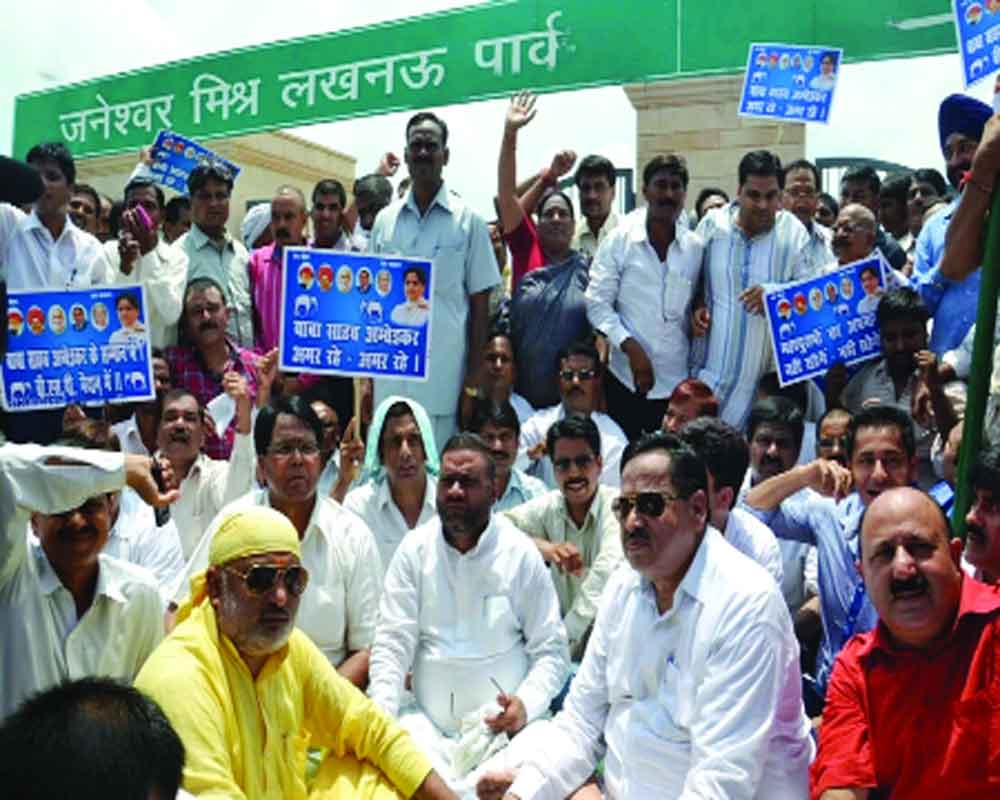BSP leader and former Chief Minister Mayawati has once again broached the issue of statehood for western UP, probably to remain electorally relevant in the days ahead
The first phase of polling in western Uttar Pradesh is over. On April 19, the Lok Sabha constituencies of Saharanpur, Kairana, Muzaffarnagar, Bijnor, Nagina, Moradabad, Rampur and Pilibhit witnessed polling.
The next phase of polling is scheduled for April 26, when the constituencies of Amroha, Meerut, Baghpat, Ghaziabad, Gautam Buddha Nagar, Bulandshahr (reserved), Aligarh, Meerut and Mathura would go to the hustings.
On these seats, Bahujan Samajwadi Party (BSP) leader and former Chief Minister Mayawati has trumpeted the old issue of a separate State for West UP, probably to remain electorally relevant in the times to come. Choosing the birth anniversary day of the man credited with the drafting of the Constitution, Dr BR Ambedkar, Mayawati made a major announcement at a rally in Muzaffarnagar of according Statehood to western UP and also establishing a bench of the Allahabad High Court in the region, if voted to power at the Centre.
This has once again brought the issue of Harit Pradesh, the name envisioned for western UP by late Chowdhary Ajit Singh, the erstwhile leader of the Rashtriya Lok Dal and heir of Chowdhary Charan Singh, the tallest leader of West UP. The supporters of the formation of Harit Pradesh claim that it was Dr Ambedkar who had proposed the division of Uttar Pradesh into three separate States — Western, Central and Eastern — for better governance.
In 1955, Dr Ambedkar proposed the idea of splitting Uttar Pradesh into three States through his book, ‘Thoughts on Linguistic States’. He suggested the creation of three States, with Meerut as the capital of the Western Region, Allahabad as the capital of the Eastern Region and Kanpur as the capital of the Central region.
This is what the BSP had in mind while proposing the split in 2011. During her reign as the Chief Minister, Mayawati had backed a resolution which got passed in the Uttar Pradesh Legislative Assembly for breaking the State into four smaller States — West, Central, East and Bundelkhand. One part of the undivided Uttar Pradesh, Uttarakhand, consisting of hill districts, had already been carved out in 2000. However, unlike Dr Ambedkar’s thought, Mayawati’s push is based on the arithmetic of electoral politics.
When she proposes a separate State for western Uttar Pradesh, she has in mind the substantial Dalit and Muslim population inhabiting the region. It was Mayawati’s D-M (Dalit-Muslim) combination which had defeated the Samajwadi Party’s M-Y (Muslim-Yadav) formation to wrest power in Uttar Pradesh in 2007.
Working as a reporter for this publication in the early part of this century, one still remembers how the dominating community of the Jats and other upper castes, by the way of landholding rights, managed to keep the Dalits at bay from electoral process. The late Editor of the paper, Dr Chandan Mitra, had once given a headline to this reporter’s story which said, ‘Fair polls, free of Dalits’.
It was only after the rise of the BSP, especially from the 2004 Lok Sabha election onwards, that the Dalit population of western UP got involved in the process not just in word but also in spirit. This is the time which also saw the emergence of D-M, which changed the electoral calculus of the State.
This area has also seen the rise in the Muslim population. As per the 2011 Census, the total population of western Uttar Pradesh is 71,217,132, out of which 72.29 per cent is Hindu and 26.21 per cent is Muslim. The population in the Khadiboli region is 29,669,035 (Hindus 59.19 per cent and Muslims 39.17 per cent) and the population of the Braj region is 29,754,755 (Hindus 82.78 per cent and Muslims 16 per cent). The districts speaking Khadiboli, a slightly coloquial version of the Hindi language, include Muzaffarnagar, Saharanpur, Shamli, Baghpat, Ghaziabad, Meerut, Hapur, Amroha, Bijnor, some parts of Moradabad, Gautam Buddha Nagar and Bulandshahar. The Braj-speaking districts include Mathura, Hathras, Agra, Aligarh, Etah and some parts of Gautam Buddha Nagar, Bulandshahr, Etawah and Mainpuri.
The Muslim population share in the eight districts of Saharanpur, Muzaffarnagar, Bijnor, Moradabad, Rampur, Jyotiba Phule Nagar, Meerut and Bareilly has increased from 29.93 per cent in 1951 to 40.43 per cent in 2011. This has made the Bharatiya Janata Party (BJP) raise the demand for the population control Bill, fearing a loss for space for the Hindu groups.
No wonder there is a lot more than meets the eye than the mere explanation behind the demand for a separate State for good governance. It has more to do with politics than people.
(The writer is a political analyst and president, Centre for Reforms, Development & Justice; views are personal.)


























